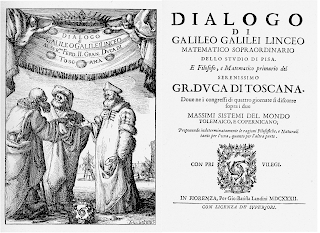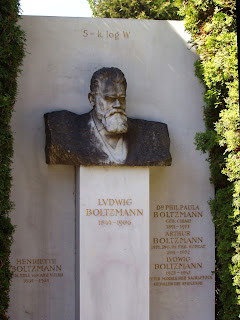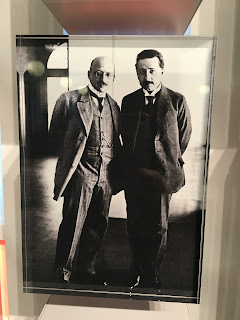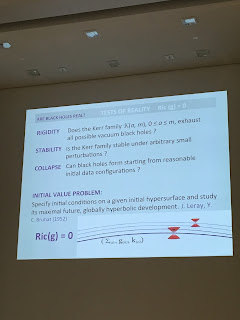Some of the greatest insights in physics have come out of paradoxes and incompatibilities between well-established theories of nature and newly observed phenomena. In Part 1 of this blog, we saw the development of classical physics up to the 19th century. At the dawn of the 20th century, it was widely believed that the end of physics was near. Lord Kelvin, a pre-eminent physicist of the day is said to have famously pronounced (in a possibly apocryphal event) "There is nothing new to be discovered in physics now, all that remains is more and more precise measurement". Newton's laws were spectacularly successful in describing the motion of bodies, both earthly and celestial. The macroscopic and thermodynamic properties of matter could be explained in terms of the statistical behavior of atoms that obeyed Newtonian mechanics. Maxwell's equations gave a complete mathematical description of electromagnetic phenomena. While Faraday's original formulation of electromagnetic theory did not postulate any medium for the transmission of electromagnetic fields, it was widely believed that an all-pervading material called the aether was the medium for electromagnetic phenomena. Even Maxwell is said to have believed that electromagnetic waves traveled as oscillations of the aether. Also, classical physics at the turn of the century rested on the twin foundations of causality and determinism. These principles demanded that given initial conditions, the dynamic evolution of any system is governed by physical laws that can be expressed by differential equations, whose solutions allow precise calculation of positions and velocities of particles involved in the dynamics of the system.
However, there were some ominous clouds gathering over the prevailing sense of completeness and finality in the subject. Attempts to fit the Faraday-Maxwell theory of electromagnetism into the mechanistic framework of the aether were ad hoc at best. No experiment could detect the all-pervading aether. Precise experiments such as those of Michelson and Morley failed to detect any changes in the speed of light due to the earth's motion through the aether (unlike for example the change in the speed of sound due to the motion of the sound source through the air). There were other vexing astronomical anomalies such as the perihelion motion of Mercury's orbit. On the earthly front, the existing wave theory of light could not explain the photoelectric effect, where light shining on a metal resulted in the production of an electric current whose energy depended only on the frequency of the light as opposed to the intensity of the light. There were still many questions about the existence of atoms, their structure, and their relationship to radiation phenomena. But what triggered the quantum revolution was the problem of "black body" radiation.
The Quantum Revolution
Numerous attempts to fit this realization into known classical models of electromagnetic theory and Newtonian mechanics met with failure. In the early 1920s, de Broglie and Schrödinger developed a wave theory of matter that carried a tremendous intuitive and visual appeal to classical physicists. Schrödinger's famous equation was also a major milestone that allowed one to describe the time evolution of a system using a "state vector" known also as the wave function. Schrödinger's interpretation of the wave function was in terms of physical "matter waves". But it became clear over the next 2 decades largely due to the work of Heisenberg, Pauli, Max Born, and most importantly Niels Bohr, that all visual and classical ideas of nature had to be abandoned when it came to atomic phenomena. The consensus that emerged (known as the Copenhagen Interpretation) was that wave and particle were complementary aspects of nature that manifested themselves depending upon the kind of experiment that was being performed. All measurements carry an inherent uncertainty where dual observables such as position and momenta cannot be simultaneously measured with unlimited precision. The wave function itself is an "infinite-dimensional" mathematical entity, whose only physical interpretation is that its "modulus square" represents the probability of finding a particle at a location during a measurement. Interestingly the author of this probabilistic interpretation of quantum mechanics (Max Born) attributed the idea originally to Einstein, who had suggested in an unpublished manuscript that the wave nature of light actually represented a "wave of probabilities" of photons. However, Einstein believed that these probabilities applied to an ensemble of photons and not to an individual photon. When it came to individual particles, Einstein firmly believed that deterministic laws would apply. On the other hand, Max Born's interpretation of the wave function and the later Copenhagen interpretation of quantum mechanics asserted that determinism did not apply to atomic phenomena. When it came to atomic measurements one could only speak in terms of probabilities. Einstein never accepted this "probabilistic" interpretation of quantum mechanics and maintained till the end of his life that "God does not play dice with the universe". The debates that raged between Bohr, Heisenberg, Schrödinger, and Einstein could be counted as one of the greatest philosophical debates of all time. The Copenhagen interpretation of quantum mechanics is widely accepted by physicists today with some notable exceptions.
As Feynman stated in his numerous lectures, it is safe to say that nobody really understands quantum mechanics. Niels Bohr, one of the founding fathers of quantum theory stated that anyone who is not shocked by quantum mechanics has not really understood it. But it is indeed one of the most successful theories of nature and is the foundation of much of modern physics and technology. Quantum mechanics plays a foundational role in solid-state physics, condensed matter physics, the theory of superconductivity, nuclear physics, stellar evolution, particle physics, modern chemistry, and even modern biology. Today's technology including semiconductors, lasers, MRI machines, electronics, etc. would not be possible without quantum mechanics.
Even when he was wrong, Albert Einstein was remarkably prescient and insightful. His ingenious thought experiments aimed at showing that Quantum Mechanics was incomplete, culminated in the famous EPR (Einstein-Podolski-Rosen) paper that highlighted the "spooky non-local" nature of quantum entanglement of particles separated by large distances. However, entanglement is a fundamental and experimentally verified aspect of quantum mechanics. It is an active area of research in both physics and quantum information theory today. Quantum mechanics is also penetrating other areas of knowledge such as information science and computing. Research labs around the world are racing to build the first quantum computer. Such a development would transform computing and communication as we know it.
Relativity
At the turn of the 20th century, it was realized that Maxwell's equations had the strange property that the speed of an electromagnetic wave (such as light for example) seemed to be the same in all frames of reference. This was clearly incompatible with the intuitively obvious concept of relative motion. For instance, two trains moving at the same speed in the same direction appear to be at rest relative to each other. Not so with light, which seemed to travel at a fixed constant speed of 186,000 miles/sec irrespective of the speed of the observer. The speed of light (c) shows up in Maxwell's equations as a constant number that can be computed from the electrical permittivity and magnetic permeability of empty space. Maxwell himself assumed that this speed must be relative to an absolute frame of reference namely the aether. The Michelson-Morley experiment of 1887 failed to measure any movement of the earth relative to the aether. Their experiment showed that light traveled at exactly the same speed both parallel and perpendicular to the motion of the earth (which contradicted the hypothesis of a drag in the aether caused by the earth's motion). Nobody appreciated the constancy of the speed of light more deeply than Albert Einstein. After all, as a teenager, he had performed a Gedankenexperiment (thought experiment) of racing behind a ray of light and wondering what he would see. Common sense indicated that he should see a standing light wave, but that seemed to violate Maxwell's equations. Einstein was also aware of Galileo's discovery of "inertial frames of reference" and the "principle of relativity". Galileo had shown that there was no fundamental difference between a frame of reference at rest and one at uniform motion relative to it. In other words, no experiment conducted within a uniformly moving frame of reference can tell whether it is at rest or at motion. So all uniform motion seems to be relative and all laws of physics should be the same in all inertial frames of reference. Einstein in 1905, resolved the paradox of the constancy of the speed of light in all frames of reference by developing a new theory of space and time called the "Special Theory of Relativity". By elevating the "Principle of Relativity" and "the Constancy of Speed of Light" to the status of fundamental postulates, Einstein derived a host of consequences that transformed our understanding of simultaneity of events, lengths of objects, and time intervals. In Einstein's theory, space and time lost their absolute and independent nature and blended into a 4-dimensional continuum called spacetime whose geometry was such that no signal could travel faster than the speed of light. The mathematician Hermann Minkowski announced rather dramatically in a 1908 speech, "henceforth space by itself and time by itself are doomed to fade away into mere shadows, and only a kind of union of the two will preserve an independent reality". Some of the remarkable consequences of this theory were length contraction of moving objects, time dilation (slowing down of moving clocks), and the famous equivalence of mass and energy given by the equation E = mc^2.
Revolutionary as the special theory of relativity was, there were some unsatisfactory aspects to it, at least as far as Einstein was concerned. The circular nature of the definition of an inertial frame had not escaped his attention. Clearly, the notion of an inertial frame was a kind of idealization or approximation. If you were far away from all other objects and if there were no measurable forces then you could treat your frame of reference as an inertial one. The special status given to inertial frames irked him and made him ask the question as to why the laws of physics would not be the same in ALL frames of reference (and not just inertial frames of reference). In this, he was influenced by the philosophical ideas of Ernst Mach. Further, he puzzled over the nature of gravity. Newton's law of gravity suggests an "action at a distance" that is transmitted instantaneously across distances between two masses. This clearly violates the special theory of relativity where nothing can travel faster than the speed of light. There was also the mystery of the equivalence of inertial and gravitational mass as discovered by Galileo (which is equivalent to the statement that all objects of any mass accelerate at the same rate near the earth). All of this set the stage for arguably one of the greatest leaps of human intuition since the time of Newton, namely the discovery of the General Theory of Relativity. Based not just on empirically observed facts, but on phenomenological and philosophical considerations involving frames of reference, Einstein developed a dynamic theory of space, time, and gravitation that completely revolutionized our understanding of the universe. In the General Theory of Relativity, Einstein declared that the laws of physics were the same in all frames of reference (Principle of General Covariance). Moreover, spacetime in general relativity is a dynamic entity that is curved by the presence of matter. The curvature of spacetime manifests itself as the force of gravity. Bodies in motion follow geodesics (paths of least "distance") in curved spacetime. The geometry of spacetime in the vicinity of matter can be best understood using the mathematics of non-Euclidean geometry developed by Bernhard Riemann in 1854. The language and formalism of tensor analysis were used by Einstein to derive his famous field equations of gravitation. These equations provide a precise relationship between the geometry of spacetime and the distribution of matter and energy in a region. Einstein was able to show that Newton's Law of Gravitation appeared as a limiting case when gravitational fields were weak. Einstein was able to precisely account for the observed perihelion motion of Mercury thus solving a longstanding mystery in astronomy. More remarkably he was also able to predict effects such as the bending of light due to gravity (gravitational lensing) and gravitational waves (recently detected by the LIGO observatories).
General relativity has withstood the test of time and continues to be tested by precise experiments conducted on earth and space. It is one of the two pillars of modern physics today, the other being quantum mechanics. Einstein's theory has paved the way for much of the dramatic developments in modern cosmology and astrophysics including the theory of black holes, the Big Bang theory, and the theory of the expanding universe.
However, lest one should think of Einstein's theory as an esoteric theory with no practical applications, it should be pointed out that both special relativity and general relativity play a critical role in modern GPS technology. The time dilation of atomic clocks due to the motion of satellites (a special relativistic effect) and the speedup of the clocks due to the location of the satellites above the earth (a general relativistic effect) impact the precision of calculation of the location of objects on earth. Modern GPS software accounts for the relativistic effects of geolocation. Anyone who questions the practical value of pursuing theoretical physics must stop to think about how the smartphone is able to provide precise turn-by-turn directions!
Physics Today
The last century has seen remarkable progress in the development of the physical sciences. The discovery of an expanding universe by Hubble and detection of the cosmic microwave background radiation (CMB) have allowed us to create an effective model of the universe and its evolution from the time of the Big Bang. Precision cosmology has also provided strong evidence for the inflationary expansion of the universe right after the Big Bang when the universe supposedly underwent a very rapid expansion and slowed down to allow for the creation of galaxies. X-Ray, Gamma Ray, and Infrared astronomy have provided strong evidence for the existence of extraordinarily compact astrophysical objects such as Neutron Stars and Black Holes. The recent dramatic discovery of gravitational waves by the LIGO observatories in Washington and Louisiana have provided us a window into the strange and violent nature of the universe. However, in many ways, we are in the same situation as the Greeks. Our model of the universe is incomplete and many problems remain unsolved. Two great puzzles of cosmology are the apparent presence of dark matter and dark energy. Dark matter refers to invisible matter whose presence is needed to explain the stability of spinning galaxies. Dark energy refers to a mysterious force that seems to cause the universe to expand at an increasingly rapid pace (as observed by the Hubble space telescope). It is estimated that roughly 5% of the universe is visible matter, 27% is dark matter and the rest (68%) is dark energy. However, we don't know what dark matter is and nor do we have a clear framework to describe dark energy. There are theoretical proposals such as WIMPs (Weakly Interacting Massive Particles) designed to explain dark matter. But they have not been detected in any experiment. Dark energy is supposed to be the intrinsic energy of vacuum (represented by Einstein's cosmological constant) that causes a negative pressure leading to the expansion of the universe. However, most quantum field theories predict that the energy of the vacuum has to be 100 orders of magnitude larger than what is required to explain the observed rate of expansion. Again many alternative theories have been proposed but none are conclusive.
Quantum mechanics and special relativity have been remarkably successful in explaining the properties of matter and its internal constituents. A central problem of theoretical physics is Einstein's dream of unification of the forces of nature. The Standard Model of Particle Physics has been successful in unifying the electromagnetic, strong, and weak nuclear forces into a common theoretical framework. Experiments at the LHC (Large Hadron Collider) have verified the Standard Model by detecting the Higgs Boson. However, the force of gravity has resisted attempts at unification with the rest of the forces. String theory is a potential approach to unification, but many mysteries remain and string theory is far from being testable (let alone tested). Any such unification would require a quantum theory of gravity. When gravitation and quantum mechanics meet in the strong field regime of a black hole, very interesting puzzles emerge. The most interesting of these is the apparent loss of information due to the evaporation of a black hole due to Hawking radiation. All of these puzzles, the proliferation of proposed theories to resolve them and the experimental attempts to probe higher energies and deeper realms of the cosmos suggest that we are at the cusp of another paradigm shift in our understanding of the universe.
Perspikacia
From ancient times to the present day, deep contemplation, precise reasoning, mathematical analysis, careful observation, and sophisticated experimentation have shown us that the world is not as it seems to be nor is it as one may imagine or wish it to be. Time and again visionary individuals such as Galileo, Newton, Faraday, Maxwell, Einstein, Bohr, Dirac, Feynman, Hawking, and many others have used their perspicacity to give us dramatically new perspectives on the inner workings of nature. In Science as in great art, it is individual perspicacity that produces shifts in human consciousness that deepens our understanding of the universe. While in some cases these individuals are driven by just "the pleasure of finding things out" (Feynman), in other cases they are propelled by the desire to "know the mind of God" (Einstein). There is something in human consciousness that takes pleasure in understanding the order of things.
"The scientists’ religious feeling takes the form of a rapturous amazement at the harmony of natural law, which reveals an intelligence of such superiority that, compared with it, all the systematic thinking and acting of human beings is an utterly insignificant reflection." - Albert Einstein
































